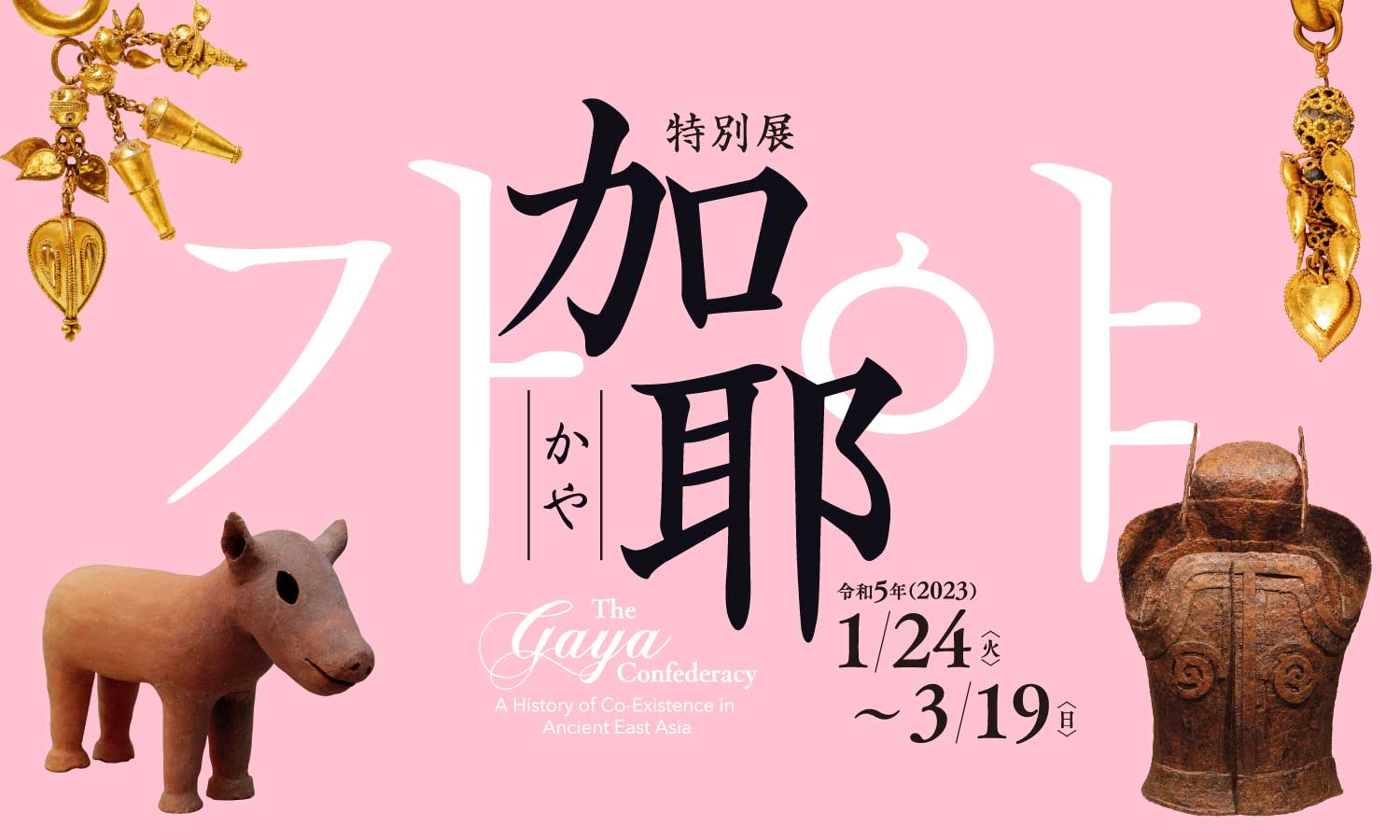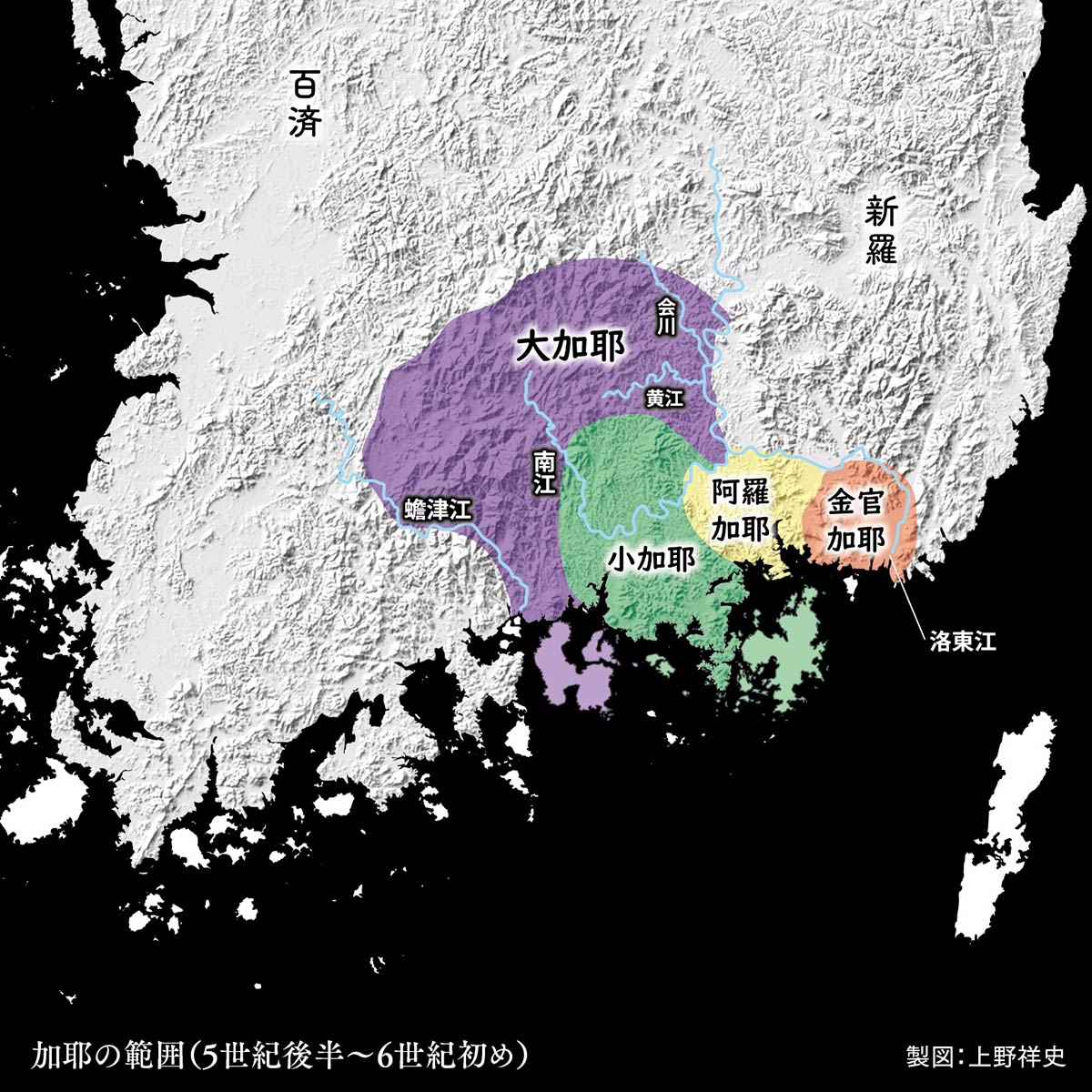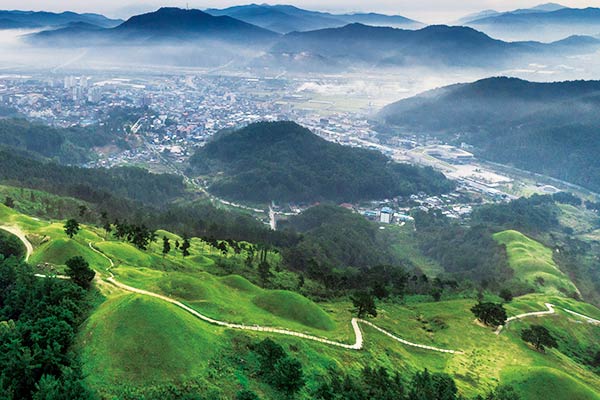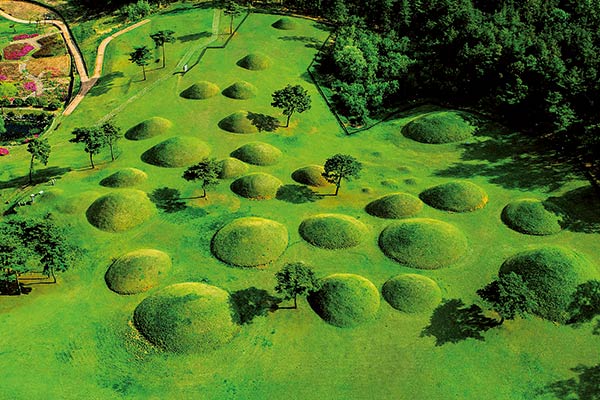

Special
Exhibition
The Gaya Confederacy
A History of Co-Existence in Ancient East Asia
Exhibition Period:
24 January – 19 March 2023
Venue:
Special Exhibition Hall (3rd floor)
Opening Hours:
09:30–17:00 (Sundays, Tuesdays–Thursdays; last admission at 16:30)
09:30–20:00* (Fridays and Saturdays; last admission at 19:30)
*Opening hours may change during the exhibition period
Closed:
Mondays
Admission Fees:
Adults—1,700 yen
University and High School Students—1,000 yen
Junior High School and Elementary School Students—600 yen
University and High School Students—1,000 yen
Junior High School and Elementary School Students—600 yen
Advance Online Tickets:
Adults—1,500 yen
University and High School Students—800 yen
Junior High School and Elementary School Students—400 yen
Tickets include entry into the Cultural Exchange Exhibition on the fourth floor.
For discounted tickets, please present personal identification documents that reflect your birth
date, such as your passport, health insurance card, or driver’s license at the exhibition hall
entrance upon request.
Admission is free for the following
persons:
Tickets:
Advance tickets are available from now to 23 January 2023. You may purchase them online via ARTNE (English interface available) and Lawson Tickets, or in person from commuter pass sale counters in Nishitetsu Tenjin Station (Level 1, Solaria Stage), ACROS Fukuoka’s ticket center, and Kyushu National Museum’s Museum Shop. After advance ticket sales end, visitors may still purchase full-price tickets in person at the ticketing counters at ACROS Fukuoka and on the first floor of the museum, or online at the websites provided above. Tickets can also be purchased in person at Lawson’s (L-code: 81904). To prevent overcrowding at the ticketing counters, we recommend that visitors purchase tickets online prior to their visit.
List of Works:
Special Arrangements for COVID-19
- We request that all visitors wear masks when visiting the museum. We reserve the right to turn away visitors with a fever of 37.5°C or higher, as well as visitors exhibiting cold-like symptoms.
- Please note that exhibition details are subject to change depending on the COVID situation. Please check our website for the latest updates.
Exhibition Highlights

Dae Gaya
Treasure (Korea)
Gilt-bronze crown
From the Jisan-dong tumulus no. 32, Goryeong, Korea
Mid-5th century
Daegu National Museum, Korea
(Image provided by Heongso Museum, Keimyung University)
The kings of Dae Gaya were laid to rest in the Jisan-dong tumuli. This crown, which represents their power and authority, features a large decoration on its apex and fine, wave-shaped motifs made from small dots on its body.

Dae Gaya
Gold earring
From the Okjeon tumulus M4, Hapcheon, Korea
Early 6th century
Jinju National Museum, Korea
*The right-side earring will be displayed during this exhibition
Earrings from Dae Gaya often feature decorations attached to the clasp with fine chains. The petal-shaped ornaments at the top of each chain were made in the image of gardenia (kuchinashi) flowers. They are characteristic of sixth-century objects and can be found both in Japan and other regions.

Ara Gaya
Ceremonial ornament with spikes
From the Dohang-ri tumulus no. 10 (M), Haman, Korea
Late 4th–early 5th century
Gimhae National Museum, Korea
This ceremonial ornament was made from an iron ingot, and features bird-shaped spikes around its edges. Iron was a key part of life at the time—in addition to being the raw material for manufacturing tools, it was also used occasionally in the creation of burial objects such as coinage.

Geumgwan Gaya
Cuirass
Reportedly from Teorae-ri, Gimhae, Korea
4th century
National Museum of Korea
Geumgwan Gaya grew in prosperity due to its iron production and trade. With this, however, came enemies and adversaries, necessitating the production of iron armor. They were made with long, vertical iron strips that were joined together and decorated with spiral motifs.

Dae Gaya
Horse helmet
From the Okjeon tumulus M3, Hapcheon, Korea
Late 5th century
Jinju National Museum, Korea
Horse trappings were first developed in the fifth century and produced all over the Korean peninsula. Horse helmets such as these were particularly valuable, and their presence in the Okjeon tumuli, in which leaders from Dae Gaya were buried, show how this period was the pinnacle of Gaya’s history and culture.

Dae Gaya
Glass vessel
From the Okjeon tumulus M1, Hapcheon, Korea
Late 5th century
Jinju National Museum, Korea
This glass vessel is likely of Middle Eastern origin and came to Gaya through Silla, showing how exchange between these two cultures was well and alive in the late fifth century.

Geumgwan Gaya
Duck-shaped earthenware vessel
From the Mangdeok-ri tumulus no. I-194, Gimhae, Korea
4th century
Gimhae National Museum, Korea
Duck-shaped vessels such as this one were produced from around the third century onwards. This particular vessel features a small human figure on top of the duck’s head. According to passages from the Wajinden, a third-century chronicle from the Chinese Records of the Three Kingdoms, birds were thought to be mediators between the living and the dead.

Wa Japan
Chiba Prefecture–Designated Cultural Property
Haniwa funerary figurine modeled after an immigrant
From the Yamakura tumulus no. 1, Chiba
6th century
Ichihara City Board of Education, Chiba
The long sleeves on this haniwa figurine, which cover the figure’s hands, are characteristic of attire worn by immigrants to Japan from this time. Figurines such as this were used to replicate scenes from funerary rites of the time, and as such point to the involvement of immigrants in such customs in the Kanto area.

Wa Japan
Important Cultural Property
Gold earrings
From the Niizawa-senzuka tumulus no. 126, Nara
5th century
Tokyo National Museum
These earrings were worn by an extravagantly-dressed woman of considerable influence who was laid to rest in the Niizawa-senzuka tumulus. The use of chains in these earrings is similar to those from Dae Gaya. She was also buried wearing gold rings, gold and silver bracelets, jade comma-shaped beads of Japanese origin, and other accessories.

Wa Japan
Nagano Prefecture–Designated Cultural Property
Iron swords
From the Netsuka site, Nagano
2nd–3rd century
Kijimadaira Village Board of Education, Nagano
The Netsuka site turned up swords made from iron that had been manufactured in Byeonhan, the confederacy preceding Gaya, as well as earthenware originating from the Korean peninsula. These objects point towards a history of Yayoi-period cultural exchange that extended as far as inland Eastern Japan.

Wa Japan
Cuirass
From the Otachausuzuka tumulus, Fukuoka
5th century
Asakura City Board of Education, Fukuoka
Armor made from long, horizontal iron plates, such as this cuirass, was developed in Japan. Similar sets of armor were exported to Gaya in the mid-fifth century, when cultural exchange between these two cultures was at its most prosperous.

Wa Japan
Shijōnawate City–Designated Cultural Property
Haniwa funerary figurine of a baby horse
From the Shinobugaoka-ekimae ruins, Osaka
6th century
Shijōnawate City Board of Education, Osaka
Following the proliferation of horse-riding in culture from the Korean peninsula, areas in Japan saw the emergence of ranches made specifically for raising horses. Haniwa figurines such as this one, which depicts a baby horse without any trappings, help paint a picture of what these ranches might have looked like at the time.
The Gaya Confederacy
Regions in the southern portion of the Korean peninsula grew in affluence and power with the advent of iron production in the third century. People who lived there began wearing gold accessories and started building large tombs for kings. These loosely-linked polities, collectively known as the Gaya confederacy, engaged in cultural exchange with Silla to the east, Baekje and China to the west, Goguryeo to the north, Wa (ancient Japan) to the south, as well as islands further southwest.

Purple: Dae Gaya; green: So Gaya; yellow: Ara Gaya; orange: Geumgwan Gaya
The First “Gaya”:
Geumgwan Gaya
This polity was mentioned in the Wajinden, a third-century chronicle on Wa (ancient Japan) from the Chinese Records of the Three Kingdoms, as “狗邪韓国.” It was the first to be referred to as “Gaya,” and prospered in the fourth century. Their kings were buried in the Daesong-dong tumuli.
Creative and Imaginative:
Ara Gaya
This polity is characterized by the imaginative and creative objects it produced, such as spiked ceremonial objects made from iron ingots, and earthenware vessels with unique features like flame-shaped openwork, or rotatable wheels. Their kings were buried in the Marisan tumuli.
Closest to Japan:
So Gaya
This polity faced the sea, and consequently developed a deep relationship with Wa. It also acted as a mediator between Dae Gaya and Wa. Their kings were buried in the Songhak-dong tumuli.
Strongest of Them All:
Dae Gaya
This polity gained prominence from the fifth century onwards, and held enough influence and power to send their own envoys to China. Towards the end of the confederacy’s existence, Dae Gaya fought against annexation by Silla with other polities in the region. Their kings were buried in the Jisan-dong tumuli.

Jisan-dong tumuli, Goryeong

Okjeon tumuli, Hapcheon